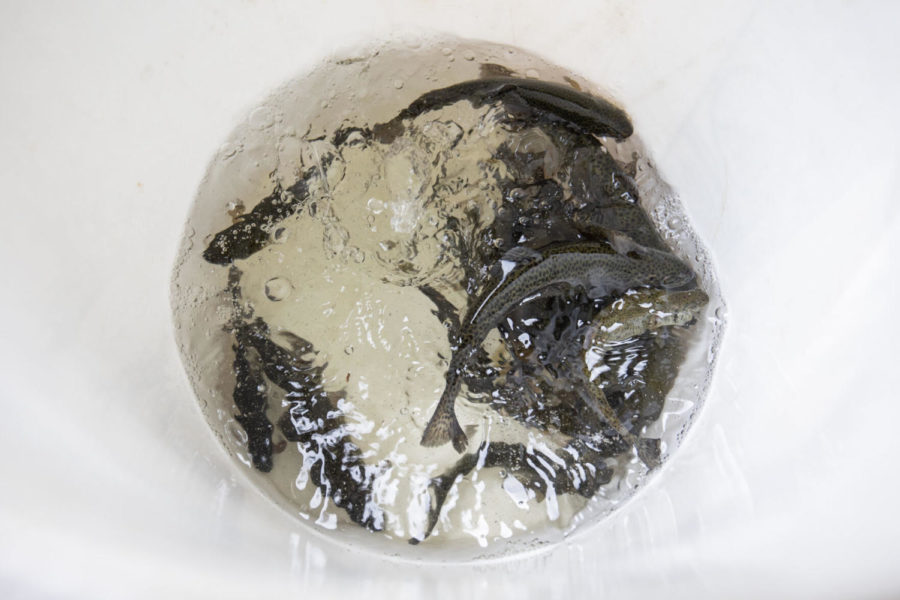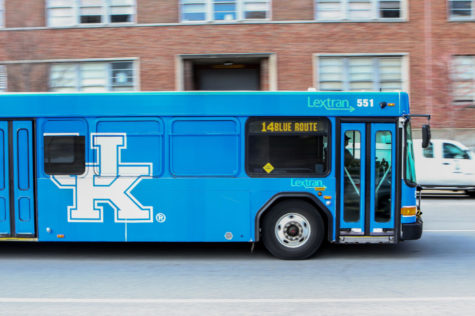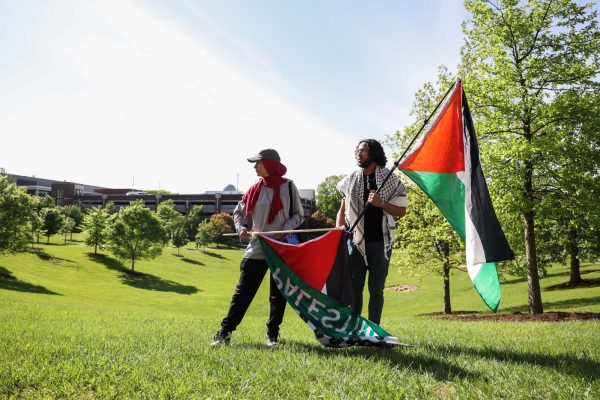Bag to backpack to stream: Trout stocking in Red River Gorge
November 11, 2020
My fish are not happy.
I don’t know that for certain, but I imagine that being dumped into a plastic bag with 17 of their brothers and sisters, thrown into darkness and then being carried on the fish equivalent of a roller coaster isn’t their preferred activity.
I can feel them sloshing and swimming against my back, so I feel that we have a connection, my fish and I. Enough that by the time we get to our destination – a stream in Red River Gorge – I will have given them most of them names (Natasha, Bernard, Gregorovich) and be very sad to unceremoniously dump them out of their current home, my backpack.
Justin Heflin, the fisheries biologist leading this expedition, says it is better to dump the fish from chest height than to take them out by hand and ease them into the water because the shock will get them moving faster.
Scientifically, I understand; setting my fish free is the goal of this endeavor, a trout stocking trip with the Kentucky Department of Fisheries and Wildlife. (But I still wanted to hold my fish and wish them good luck).
Heflin manages the trout streams in 23 counties in northeast Kentucky; he’s been in his position for four years, coming off four years in a similar role in Virginia. He said trout was on his plate from the beginning because it wasn’t huge in Kentucky.
“With my previous experience from Virginia and from the mountains of Virginia, we had a lot of trout and it’s always been a passion of mine,” Heflin said. “So to me, it’s not labor intensive at all, I actually enjoy it. Not a lot of people can say that they get paid to hike the Gorge, and that’s definitely a big benefit to my job.”
Heflin conducts trout stocking several times a year, usually in October. I accompanied him and the volunteers at Dog Fork and Chimney Top, two of the streams KDFW has listed as potential sites.
Trout are not native to Kentucky. An avid fisherman, Bill Holmes, began illegally stocking trout in the streams of Red River Gorge in the 1960s after smuggling them in from Pennsylvania. Now, KDFW is attempting to start trout populations in the same streams that Holmes identified as suitable for the species.
“How we determine if it’s going to continue to get trout or which of those three categories it falls into are all based are based largely on water temperature,” Heflin said. They have a threshold they can sustain as far as top end, most of the time, we say roughly about 70 degrees, but that kind of fluctuate between species.”
The categories are put-and-grow, grow-and-take and catch and release. Most of the trout streams Heflin stocks are put-and-take, where anglers can catch fish; put-and-grow has a delayed harvest regulation, usually until March.
“We know that the summer months is really hard on them and most of them won’t survive,” Heflin said. “So in order to avoid that, we open up harvest after that time frame and allow people to take them out when they want it.”
Fishing is one of the main motivations for the trout stocking program. KDFW gets revenue from taxes associated with fishing – poles, lures, licenses – and similar hunting supplies. So, having more fish available in local streams increases revenue for the department.
“In the end, it is primarily for recreation, for people to be able to go down there and catch them. Especially a self-sustaining population is since they’re non-native, they’re not from here,” Heflin said. “But if you get them self-sustaining, then they can earn the title of wild. And people really like to catch fish that are wild.”
The trout stocked by Heflin and volunteers – both brook and rainbow – are grown at Wolf Creek Hatchery, a federal location. They cost the state department money to purchase and staff time to stock, so a self-sustaining population would reduce input costs.
Heflin and his team – another member of the fisheries staff, or a partner from the U.S. Forest Service (which manages Red River Gorge) – drive the fish in a water tank from the hatchery to the trailhead. Once there, they pack the fish, filling a plastic bag with a couple gallons of water before scooping the fish into it, then pumping it with air before cinching the bag with rubber bands and loading it into the waiting backpacks of the volunteers.
Heflin hands me my trout for packing at Chimney Top; he tells everyone to remember when they got their fish, so that those who got bags first can dump first. Before the group gets started I practice walking around with my bag full of life, feeling like I am carrying a sack full of water on my back, because I am. I giggle repeatedly at the topsy-turvy feeling of the water sloshing around as I slip and slide my way down to the water.
Streams are picked based on temperature and fishing access. The number of fish stocked depends on the stream.
“Chimney Top is 450 and then Dog Fork and Parched Corn are 300,” Heflin said, naming three common stocking locations. “That number has some fluidity to it, but for the most part it’s kind of standardized through the state. Basically, the length of your stream and the width and stuff is factored in, and you get a kind of standardized number of fish that you would stock in that waterway.”
Temperature is the primary concern. Heflin monitors the streams with an instrument called a hobo, which transmits the stream temperature every hour of every day, 365 days a year, with a battery that lasts for five years. Currently, the streams are at borderlines temperatures for trout to succeed, partly because of an ice storm 20 years ago.
“They lost a lot of trees and the canopy cover that once covered the streams, that helps cool the streams also bugs that falls off the leaves and stuff like that. So, it’s a good food source for trout as well. Those canopies were removed by the ice storm. Currently, we’re in that regrowth stage where an early session will have to start to come back in and it’s starting to shade our streams and keep them a little bit cooler in the summer,” Heflin said.
Even the regrowth may not be enough to combat warming from climate change. Heflin said that at Chimney Top, which doesn’t have many deep pools, the rainbow trout are a last-ditch effort to see if trout will survive there, after brook and brown trout both failed (my fish will be fine, I’m sure).
He monitors the trout’s success in the spring, using backpack shocking to catch what’s around and observe their growth.
“In the past we’ve seen natural reproduction, so we see several age classes of fish. We saw like two-inch fish, which is obviously a lot smaller than what we stock so we can tell that they have had a successful spawn in there,” Heflin said. In hotter years where the trout struggle, they will be emaciated and Heflin can tell that he needs to adjust the stockings.
But the stocking program would not exist without volunteers, Heflin said.
“There’s no way we could ever be able to get enough staff employees and it would be nowhere close to profitable if we had to pay people to go down in there,” Heflin said. “This program really relies on volunteers and we try to thank them as much as we can.”
These days, the volunteers are primarily members of the Kentucky Chapter of Backcountry Hunters and Anglers, a conservation group whose only platform is access to public lands and public waters.
“How many organizations do you know that are non-partisan, completely dedicated to the mission? Everybody smiles and nobody cares what your political party is. Nobody cares what your agenda is because you don’t have one,” said Mike Abell, the vice chair of Kentucky BHA.
The group is only two years old; they were chartered in May of 2019.
According to Abell, Kentucky BHA is one of the youngest, most diverse conservation groups out there; it has around 350 members and focuses on service projects.
“A lot of conservation organizations, throw a huge fundraiser every year and use that money to help with conservation work. We actually get out and do it ourselves. We don’t raise a bunch of money,” Abell said.
The Kentucky chapter is ten years out from being able to afford a lobbyist to affect legislature, like one of the Montana chapters does.
“What we do have is elbow grease. We have sweat equity and we’re putting it we’re put in these projects,” Abell said.
Trout stocking is a project they’ve been able to help with the last two years. For BHA members, packing in a few pounds of fish isn’t much different from their preferred hobbies.
“I enjoy just getting to go out and hike. It wasn’t much different than backpacking in some-where for me, the camaraderie is really nice,” said Josh Rodamer, 5th district commissioner for BHA.
BHA’s commissioners align with the state’s fisheries commissioners, an intentional plan.
“The goal there is that Nick Hart, who is our third district director, would develop a relationship with Ralph Swallows, who is the third district commissioner appointed by the governor,” Abell said. That’s how BHA’s involvement with trout began, with Abell talking to his connections with the state.
“We had this really big plan and I gave it to the department and they were really reluctant to approve it. There was a lot of red tape. So out of frustration, I said, ‘well, why don’t you guys tell us what your project list is? You guys give us a list of projects and I’ll take that back to my Board of Directors and we’ll vote and we’ll do projects that you guys have already approved’,” Abell said.
After a few completed projects, word spread that there was a young, fit group of volunteers available.
“The fisheries guys have always struggled to find enough strong people to stock those remote streams in the Red River Gorge,” Abell said. “I guess the biologists all started talking and it was kind of a grassroots thing.”
“It’s definitely difficult to find dedicated people that are able and willing to make some of these hikes. Some of them aren’t easy to make,” Heflin said. (Case in point: the six miles at Dog Fork, where Heflin and a BHA member caught me when I fell off a rock and freed my foot from underneath another rock).
Around 15 BHA members volunteered for the Dog Fork hike after seeing the notice on Facebook and another 10 at Chimney Top.
Some had taken off from their day job; others rearranged their work from home schedule to participate. Mike DeLong used a company-provided service day to attend and his son emailed his teachers and finished his assignments early so he could come too.
BHA-ers make the hike an outing, not a chore; a helping hand up a rock face here, a dirty joke there. When I arrived at the meeting place for the Oct. 14 hike, the group was chatting as they waited for the fish tank. They come prepared with extra backpacks and look out for each other on the trail, including a stumbling college journalist that tagged along for fun. After an event the group will gather for a beer or dinner at one of a couple local spots, but the focus of the day is still the work.
“This is us busting our tail for the good and for the good of Kentucky and mankind. Just the sense of when you walk away with is what builds the camaraderie,” Abell said. “Our biggest recruiting tool are these service projects, these events. People just leave with this huge sense of accomplishment. Everyone has a good time. It’s poetry in motion, really. It’s awesome.”
So far, BHA has helped building fish boxes and refurbishing archery ranges. Their goals for the next few years, besides increasing membership, are to start chapters at Kentucky colleges and become the go-to for public lands projects in the state.
“The lofty like endgame goal is that we are looked at as the preeminent public lands, public waters conservation organization that works for everybody. It doesn’t matter if you’re horseback or a hiker or fisher, a hunter, a mountain biker, you can be you can be part of our house, even though it’s called Backcountry Hunters and Anglers,” Abell said.
Abell, a retired full-bird colonel, likened the BHA group to the teamwork of the military. Many BHA members are former military themselves, a trend that happened naturally, Abell said, because those that leave the service seek the same sense of belonging.
“We come up with these missions and through the sense of accomplishment we have, it’s just this organic camaraderie and military people gravitate towards it. It’s the thing that’s missing when we all leave service. We miss our team and we miss our mission,” Abell said.
Mission in mind, the BHA-ers follow Heflin’s plan for the trout stocking trip, each carrying about 15 fish.
“We try and get them roughly six inches is a good size,” Heflin said of the trout. “That’s mainly the size we go for because they fit in those bags really easy. They require a little less oxygen to carry them down in there.”
Depending on how many fish are in a bag, they can last bags for about two hours, just enough time to get down to the stream on some of the longer hikes. Because trout must go in water, the hikes are downhill on the way out and uphill on the way back (good for the fish, bad for me).
“We haven’t pushed them to past their limits yet. Dog Fork we had a two-hour hike and when I dumped my last bag was it was two hours. So they survived just fine,” Heflin said. “They swam off good.”
(“They’ll last a lifetime,” Heflin said to a curious BHA member on location. How long that lifetime is is another question).
At rough points in the trail, volunteers cheer “for the trout!” before gearing up to slide down a rock face or climb over or under a fallen tree (the trails in Red River Gorge are backcountry, meaning chainsaws cannot be brought into to clear a path).
Bags do pop on occasion, leaving the carrier with a wet patch down their backpack and leg. But most make it down to the stream, where Heflin has volunteers stagger their bag dumping in different pools.
It happens fast; for all the sweat and effort that goes into getting the fish to the stream, the actual release is quick. The trout begin to fan out in the stream once released, ready to fight for their survival. Many will not make it through the summer. Some may be caught by spring.
I am the first to dump my bag at Chimney Top. My fish are nonplussed – they don’t care what I’ve been through for them, how much I’ve sweated and fretted over their comfort. They don’t know how overly cautious I have been hiking my way down the steep and muddy terrain. They hardly bat an eye (do fish have eyelids?) when I dump them out in a rush of white water. But I’ve done what I was supposed to do, and set them free.
(Silly things don’t move, though. I worry about them all the way back up to the car. where I start worrying about the mud on my shoes. Some things we carry with us.)




















































































































































